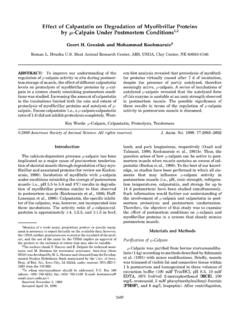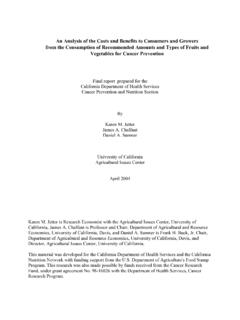Transcription of NOTICE OF RELEASE OF NB3999, NB4001, NB4002, NB6526 ...
1 UNITED STATES DEPARTMENT OF AGRICULTURE Agricultural Research Service Washington, and UNIVERSITY OF california Riverside, CA NOTICE OF RELEASE OF NB3999, NB4001, NB4002, NB6526 , NB8503, Carrot The United States Department of Agriculture, Agricultural Research Service and the california Agricultural Experiment Station announce the RELEASE of five carrot inbreds Nb3999, Nb4001, Nb4002, NB6526 , and Nb8503, with resistance to Meloidogyne incognita and M. javanica, to provide germplasm for developing improved hybrids and breeding populations. Trait Background: These five inbreds have demonstrated consistent resistance to Meloidogyne incognita and M.
2 Javanica after five (Nb3999, Nb4001, Nb4002), seven (Nb8503), or eleven ( NB6526 ) generations of selection. Resistance to M. javanica is largely conditioned by at least two loci including the Mj-llocus from the 'Brasilia' selection BR1252 (Simon et aI., Theor. Appi. Genet. 100: 735-742. 2000~ Ali et aI., J. Hered. 105: 288-291. 2014) whereas resistance to M. incognita -is conditioned by several quantitative trait loci (Parsons et aI., 2014). The precise resistance gene constitution of these inbreds is yet to be determined. Breeding and Selection History: All of these inbreds were developed from a single F1 male fertile hybrid plant of the cross between BR1252 and B6274 made in 1991.
3 BR1252 was a selection from the open pollinated cultivar 'Brasilia' which has nematode resistance, while B6274 is a smooth, mild flavored nematode susceptible 'Nantes' style USDA inbred. Seven different (BR x USDA inbred) F2 populations were evaluated for M. javanica resistance in 1992. The (BR1252 x B6274) population had the highest incidence (-80 percent) of nearly complete resistant plants among those populations tested, and was used to develop the inbreds described in this RELEASE . A total of 464 F2 plants and 103 F3 populations were evaluated for resistance to M.
4 Javanica by exposure to -30,000 nematodes eggs for each plant grown in pots at the University of california (UC) Riverside in 1994. All susceptible F2 plants that were tested generated F3 progeny that were uniformly susceptible to M. javanica. Approximately 40 percent of the resistant F2 plants produced uniformly resistant progeny while the rest of the F3 families from resistant F2 plants segregated for resistance. Resistance has been evaluated in the field at the UCR Coachella Valley Agricultural Research Station, Thermal, CA, the UC Kearney Research and Extension Center, Parlier, CA, and the UC South Coast Research and Extension Center, Tustin, CA, in plots heavily infested with M.
5 Incognita. The field in Coachella is infested with M. incognita Race 1, while those in Kearney and Irvine are infested with M. incognita Race 3. The Kearney and South Coast Stations also have separate plots infested with M. javanica, and resistance to attack by this nematode also was evaluated, but M. incognita resistance was the primary breeding goal after the first two cycles of selection for M. javanica resistance. Page 1 of3 Seed Production History and Ancillary Evaluation: Inbreds Nb3999, Nb4001, Nb4002, NB6526 , and Nb8503 were developed from selected F3 roots of uniformly M.
6 Javanica - resistant F3 families. For inbreds Nb3999, Nb4001, Nb4002, and Nb8503, from 3 to 14 roots from four resistant F3 families (where each inbred was derived from a different F2 plant of the original population) were selected for smoother storage root surface with darker orange color, lower incidence of yellow cores, and stronger petiole attachment. Selected plants were planted in 4m x 8m pollination cages in 1996 at the University of Wisconsin West Madison Agricultural Research Station. Plants in each cage were pollinated with a nucleus of honeybees. For inbred B6526, the selection process was the same except that instead of sib-mating F3 plants to generate F3M populations, a single F3 plant was self-pollinated to generate an F4 population.
7 Subsequent generations included either self-pollinations, designated as "S", or sib-matings, designated as "M". Resulting F3 sib-mated (F3M) (or F4 for NB6526 ) seed subsamples generated from resistant carrots was also grown at the UC Desert Research and Extension Center, EI Centro, CA, where evaluation of bolting tendency and horticultural attributes including appearance, flavor (sweetness and harshness), and internal root color and carotene content (to estimate contribution to vitamin A nutrition) was made. Preliminary F 1 hybrids with several petaloid cytoplasmic male sterile inbreds and hybrids have been produced and early generation CMS counterparts (BC 1 to BC2) are available.
8 CMS restoration has not been observed, suggesting these inbreds are CMS maintainers. Root Appearance and Crop Performance: Roots ofNb3999, Nb4001, Nb4002, NB6526 , and Nb8503 are 12 -20 cm long, orange, cylindrical to slightly conical, and variable in smoothness, strength of petiole attachment, seed productivity and tendency toward early bolting. These inbreds display a variable level of resistance to Alternaria dauci (Alternaria leaf blight) based upon evaluations made under natural field exposure to this disease over 6 years at the UW Hancock Agricultural Research Station, Hancock, Wisconsin.
9 Intercrosses have been made between all of these inbreds and nematode susceptible carrot inbreds in the "Imperator" category, as well as between these resistant inbreds to evaluate combining ability for root appearance. Several of these experimental hybrids received very good ratings based on visual evaluation by carrot growers and breeders in annual "cello" carrot trials at the UC Desert Research and Extension Center that included the major "cello" carrot cultivars currently grown. Experimental hybrids among Nb inbreds have been grown in multi-hectare trials on root-knot nematode infested commercial carrot production fields and resistance held up well.
10 Seed Request Instructions, Credit to the Selection Team, and Acknowledgements: Seed of carrot inbreds Nb3999, Nb4001, Nb4002, NB6526 , and Nb8503 is available for distribution to plant breeders, geneticists, pathologists and other research personnel upon written request to Philipp W. Simon, USDA, ARS, Vegetable Crops Research Unit, Dept. of Horticulture, 1575 Linden Drive, Madison, WI 53706. Efforts of Philip A. Roberts and William Matthews of the University of california - Riverside in nematode resistance evaluation and steckling production, of Joe Nunez of the University of california Cooperative Extension, Bakersfield, CA, in field trialing, and of Robert Kane and Douglas Senalik of the USDA -ARS in seed production and carotenoid evaluation, respectively, as well as funding from the california Fresh Carrot Advisory Board (to PAR and PWS), USDA Specialty Crop Research Page 2 of3 --------------Initiative award 2008-51180-04896 (to PWS and PAR)



















